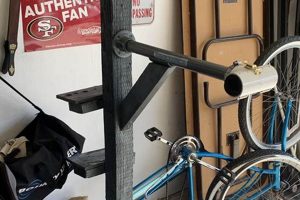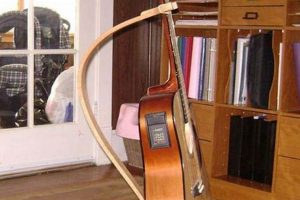Structures designed to elevate loudspeakers off the floor, often crafted from readily available materials, are essential for optimizing audio fidelity in listening environments. These supports, frequently assembled at home, isolate the speaker cabinet from the floor, reducing unwanted vibrations that can muddy the sound. Such constructions come in varied forms, utilizing materials like wood, metal, or concrete, each influencing the final acoustic performance.
Employing these custom-built platforms yields significant advantages. By minimizing the transfer of resonant frequencies, a clearer, more accurate sound reproduction is achieved. Historically, such elevated platforms have been used in professional recording studios to decouple monitor speakers from the mixing console, ensuring accurate sonic assessments. The cost-effectiveness of these projects, along with the potential for customization to suit individual aesthetic preferences and room acoustics, contributes to their widespread appeal among audiophiles.
The subsequent sections will explore the diverse design considerations, material choices, and construction techniques involved in fabricating these personalized loudspeaker supports, providing a detailed guide to creating effective and visually appealing solutions for improved audio experiences.
Guidance for Fabricating Loudspeaker Elevation Structures
The construction of personalized platforms for loudspeaker elevation requires careful consideration of both acoustic principles and structural integrity. These guidelines aim to assist in creating effective and aesthetically pleasing supports.
Tip 1: Select materials based on desired acoustic properties. Denser materials, such as hardwoods or concrete, generally provide better damping characteristics, reducing unwanted resonances. Softwoods may require additional damping treatments.
Tip 2: Ensure structural stability by using appropriate joinery techniques. Mortise and tenon joints, dowel joints, or reinforced screws contribute to a robust and stable platform, preventing unwanted movement or vibrations.
Tip 3: Decouple the loudspeaker from the platform using isolation pads or spikes. These elements minimize the transfer of vibrations between the speaker cabinet and the support structure, resulting in clearer audio reproduction.
Tip 4: Consider the height and tilt of the platform to optimize the listening angle. Tweeters should ideally be at ear level when seated in the listening position. Adjustable tilt mechanisms can further refine the soundstage.
Tip 5: Implement cable management solutions to maintain a clean and organized appearance. Routing cables through the structure or employing cable ties prevents them from interfering with the platform’s stability or aesthetics.
Tip 6: Apply a durable finish to protect the material from environmental factors and enhance its visual appeal. Consider the acoustic properties of the finish, as some coatings may dampen or reflect sound waves.
Tip 7: Regularly inspect the structure for signs of wear or damage. Loose joints, cracks, or corrosion can compromise the platform’s stability and acoustic performance. Address any issues promptly to maintain optimal functionality.
Adhering to these guidelines facilitates the creation of loudspeaker supports that enhance both the acoustic performance and aesthetic appeal of the audio system, improving the overall listening experience.
The following sections will delve into specific design examples and address common challenges encountered during the construction process.
1. Material Resonance
Material resonance represents a critical consideration in the design and construction of loudspeaker support structures. The inherent properties of the chosen material directly influence the propagation and damping of vibrations, subsequently affecting audio fidelity. Selecting materials with favorable resonant characteristics is paramount for optimizing the acoustic performance of the entire system.
- Natural Frequencies
Every material possesses natural resonant frequencies at which it vibrates most readily. When a loudspeaker cabinet transmits vibrations to the support, these frequencies can be excited, leading to unwanted coloration of the sound. Denser materials, such as hardwoods or concrete, typically exhibit higher resonant frequencies, potentially minimizing audible interference. Conversely, lighter materials may require additional damping treatments to mitigate these effects.
- Damping Characteristics
Damping refers to a material’s ability to dissipate vibrational energy. Materials with high damping characteristics, like certain types of engineered wood or constrained-layer damping composites, effectively reduce the amplitude and duration of vibrations, preventing them from propagating and coloring the sound. Conversely, materials with low damping characteristics, such as thin metal sheets, can amplify vibrations, resulting in undesirable resonance.
- Material Composition and Construction
The composition and construction methods employed significantly influence material resonance. Solid wood structures, for instance, exhibit different resonant properties compared to composite materials like MDF (Medium-Density Fiberboard) or plywood. Furthermore, the type of joinery used and the application of adhesives can alter the overall resonant behavior of the assembled platform. Consider using screws or reinforced methods.
- External Damping Treatments
Even materials with inherent resonant issues can be treated to mitigate unwanted vibrations. Applying damping materials, such as constrained-layer damping sheets or viscoelastic polymers, to the surface of the support can effectively absorb vibrational energy, reducing resonance and improving audio clarity. These treatments provide a cost-effective means of optimizing the acoustic performance of supports constructed from less-than-ideal materials.
The selection of appropriate materials and the implementation of effective damping strategies are fundamental to mitigating the adverse effects of material resonance in loudspeaker support structures. By carefully considering these factors, the creation of platforms that minimize unwanted vibrations and enhance audio fidelity becomes achievable, resulting in a more accurate and enjoyable listening experience.
2. Structural Integrity
Structural integrity, pertaining to the ability of a support structure to withstand applied loads without failure, is paramount in the realm of loudspeaker elevation platforms. Instability compromises the acoustic performance and poses a potential safety hazard. An inadequate design, utilizing insufficient materials or improper joinery, leads to undesirable vibrations and potentially catastrophic collapse. For instance, a stand constructed from thin plywood with poorly executed butt joints will exhibit excessive flexure and is susceptible to structural failure under the weight of even a moderately sized loudspeaker.
The relationship between structural integrity and the design of loudspeaker stands is causal: the design and materials dictate the structure’s ability to support the load. Designs should consider the weight distribution of the loudspeaker and employ materials with sufficient strength and stiffness to resist bending and shear forces. Examples include utilizing solid wood or steel for the primary support members and employing techniques such as mortise and tenon joints or welding to ensure robust connections. The inclusion of a wide base and properly calculated support angles also contributes to increased stability. Without proper implementation, structural compromise can be observed in real-world applications, leading to sound degradation or, in extreme cases, equipment damage or personal injury. Neglecting to properly factor in weight and material properties inevitably leads to failure over time.
In summation, ensuring sufficient structural integrity is a non-negotiable aspect of loudspeaker platform construction. A stable and robust platform is essential for realizing the intended acoustic benefits and for safe operation. This consideration necessitates a meticulous approach to design, material selection, and construction techniques. While cost savings may be tempting, compromising structural integrity poses unacceptable risks. Prioritizing a structurally sound design ensures optimal performance and long-term reliability, contributing significantly to an enhanced listening experience.
3. Acoustic Decoupling
Acoustic decoupling, in the context of speaker stands, refers to the practice of minimizing the transmission of vibrational energy between the loudspeaker cabinet and its supporting structure, including the floor. The rationale behind this practice lies in the fact that uncontrolled vibrations can introduce unwanted resonances and coloration into the audio signal, degrading sonic clarity and accuracy. The effect of uncontrolled vibrations can be understood in comparison: a loudspeaker placed directly on a wooden floor will often produce a muddier, less defined bass response due to the floor itself vibrating sympathetically with the speaker. Conversely, a loudspeaker placed on a stand that incorporates decoupling elements exhibits a cleaner, more precise sound, as the vibrations are effectively isolated.
Several techniques are employed to achieve acoustic decoupling. Common methods include the use of compliant materials, such as rubber pads, foam, or specialized isolation feet, placed between the speaker and the stand. Another approach involves the use of spikes or cones, which reduce the contact area between the speaker and the stand, thereby minimizing the transfer of vibrations. In the realm of the construction of speaker stands, selecting materials with inherent damping properties can reduce the excitation of the supporting structure. For instance, filling the hollow support columns with sand or other dense materials can dampen internal vibrations. The selection of materials in the stand design and their positioning and utilization has consequences for the audibility of the sound output.
In summary, acoustic decoupling is an indispensable aspect of proper speaker stand design and construction. By minimizing the transmission of unwanted vibrations, decoupling techniques yield a measurable improvement in audio quality. The use of compliant materials, spikes, and strategically placed damping elements contribute to a cleaner, more accurate sound reproduction. While the specific methods and materials employed may vary depending on budget and aesthetic preferences, the underlying principle of acoustic isolation remains paramount. Failure to address acoustic decoupling results in compromised sound quality.
4. Optimized Height
The vertical positioning of loudspeakers significantly impacts the perceived soundstage and overall listening experience. Within the context of personalized loudspeaker elevation structures, the concept of optimized height becomes a crucial design parameter. The elevation of the loudspeakers directly influences the arrival time of sound waves at the listener’s ears, affecting stereo imaging, tonal balance, and the perceived sense of space. Incorrect height placement leads to a compromised soundstage, characterized by poor localization of instruments, skewed tonal balance, and a diminished sense of immersion. For instance, if tweeters are significantly below ear level, high-frequency information is attenuated, resulting in a dull or muffled sound. Conversely, tweeters positioned too high can create an overly bright and fatiguing listening experience.
Achieving optimized height necessitates a careful evaluation of several factors, including the loudspeaker’s radiation pattern, the listener’s seated ear height, and the room’s acoustic properties. In practical terms, this often involves placing the tweeters at approximately ear level when the listener is seated in the primary listening position. Some loudspeakers exhibit more directional radiation patterns, requiring precise vertical alignment to achieve optimal performance. Adjustable-height elevation structures offer a practical solution for fine-tuning the loudspeaker’s vertical position. Moreover, the room’s acoustic characteristics, such as floor reflections and standing waves, can influence the perceived tonal balance at different heights. Experimentation with different heights may be necessary to mitigate these effects and achieve the desired soundstage.
In summary, the selection of appropriate elevation is an indispensable aspect of the design process for personalized loudspeaker platforms. The correct vertical positioning of loudspeakers is paramount for maximizing soundstage accuracy, tonal balance, and overall listening enjoyment. Adjustable-height elevation structures provide a means of fine-tuning the loudspeaker’s vertical position to accommodate different listening environments and individual preferences. Neglecting the consideration of optimal height undermines the potential sonic benefits of even the most sophisticated loudspeakers and audio systems. Therefore, careful attention must be given to this parameter to realize the full potential of the listening experience.
5. Cable Management
Effective cable management is an integral component of well-executed loudspeaker platforms, irrespective of whether these supports are commercially acquired or constructed independently. Disorganized cabling not only detracts from the aesthetic appeal of the listening environment but also introduces potential safety hazards and can negatively impact the structural integrity of the overall setup.
- Aesthetic Harmony
Untidy cables visually disrupt the clean lines of a carefully designed audio setup. Concealing cables within or behind elevation structures contributes significantly to a refined and professional appearance. Integration methods can include drilling channels through wooden supports or utilizing strategically placed clips or ties to secure cables discreetly. A visually harmonious environment enhances the overall listening experience.
- Structural Stability
Excessive cable clutter can compromise the stability of elevation structures, particularly if cables are placed under tension or interfere with load-bearing components. Tangled cables can exert undue pressure on joints, potentially weakening them over time. Implementing a cable management strategy that minimizes stress on the structure is crucial for ensuring its longevity and safety.
- Signal Integrity
While less directly related to structural components, poor cable management can indirectly affect signal integrity. Untidy cables are more prone to damage, kinking, or accidental disconnection. Furthermore, proximity to power cables can introduce unwanted noise into signal cables, degrading audio quality. Proper organization minimizes these risks.
- Safety Considerations
Loose cables present a significant tripping hazard, particularly in dimly lit listening rooms. Securing cables to the elevation structure or routing them along walls eliminates potential hazards and promotes a safer environment. Covering exposed wires also minimizes the risk of electrical shock.
In conclusion, cable management represents a vital aspect of elevation structure design. Addressing cable organization not only enhances the aesthetic appeal of the system but also improves the structural integrity, signal integrity, and safety of the listening environment. Neglecting cable management detracts from the overall quality and professionalism of the audio setup.
Frequently Asked Questions Regarding Loudspeaker Elevation Structures
The following addresses common queries concerning the design, construction, and implementation of personalized platforms for elevating loudspeakers.
Question 1: What materials are most suitable for constructing loudspeaker elevation structures?
Material selection hinges on a balance between acoustic properties, structural integrity, and aesthetic preferences. Dense materials, such as hardwoods, concrete, or engineered composites, generally offer superior damping characteristics and structural stability. Softwoods require supplemental damping treatments.
Question 2: How does the height of the elevation structure impact audio performance?
The elevation of the loudspeakers significantly influences the perceived soundstage. Ideally, the tweeters should be positioned at ear level when the listener is seated in the primary listening position. This alignment optimizes stereo imaging and tonal balance.Adjustable supports facilitate fine-tuning.
Question 3: Is acoustic decoupling essential, and if so, how is it achieved?
Acoustic decoupling is critical for minimizing the transmission of unwanted vibrations between the loudspeaker and the support structure. This decoupling is accomplished through the use of compliant materials, such as rubber pads or specialized isolation feet, strategically placed at contact points. Spikes also minimize the contact area.
Question 4: What joinery techniques are recommended for ensuring structural stability?
Robust joinery is paramount for a stable and safe platform. Mortise and tenon joints, dowel joints, or reinforced screws provide reliable connections. The choice of technique depends on the materials used and the desired aesthetic. Poor joinery may result in structural instability.
Question 5: How does cable management contribute to the overall quality of the setup?
Effective cable management enhances the aesthetic appeal of the system, promotes safety, and prevents cable-induced instability. Concealing cables within the structure or employing cable ties ensures a clean and organized appearance. Manage cables to avoid signal inteference and damage.
Question 6: Are external damping treatments necessary, even with dense materials?
External damping treatments can further enhance the acoustic performance of loudspeaker structures, even those constructed from dense materials. Applying damping sheets or viscoelastic polymers to the support surfaces reduces unwanted vibrations and resonance.
In conclusion, the design and construction of personalized loudspeaker platforms requires attention to material selection, structural integrity, acoustic decoupling, height optimization, and cable management. Addressing these factors enhances the aesthetic and sonic quality of the audio system.
The following section will explore case studies of successful implementations and highlight common pitfalls to avoid during construction.
DIY Speaker Stands
This exploration has underscored the multifaceted nature of constructing personalized loudspeaker supports. Effective implementation demands a thorough understanding of material properties, structural principles, acoustic decoupling techniques, height optimization strategies, and cable management best practices. Neglecting any of these considerations compromises both the aesthetic and sonic integrity of the audio system. Considerations of material integrity, resonance, and strategic construction must be at the forefront of consideration.
The creation of such structures represents a tangible investment in the enhancement of auditory experiences. A commitment to informed design and meticulous execution ensures that the resulting platforms not only elevate loudspeakers but also contribute significantly to the realization of their full sonic potential. Further exploration into advanced damping techniques and innovative material combinations promises continued advancements in this field.







